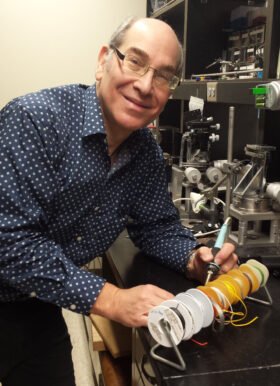The Vision Function Testing Core provides Vision Function Testing (VFT) Services and provides Electronics Services devoted to the fabrication, maintenance and modification of specialized equipment used by core investigators.
Brief overview of Vision Function Testing Services
The VFT Services include electrophysiological tests such as the Electroretinogram (ERG) and visually evoked potentials (VEPs) to assess visual function in small mammals. The VFT module also offers behavior testing to assess visual function.
ERGs measure light-evoked, electrical activity from the retina to assess rod and cone photoreceptor function, as well as signal transmission from photoreceptors to bipolar cells. Certain aspects of inner retinal function can also be assessed.
VEPs are used to assess visual signaling between the retina and the brain. VEPS are evoked potentials recorded from the visual cortex in response to a flash of light
The OptoMotry system measures visual behavior in untrained, awake animals to test visual accuity and contrast sensitivity (the ability to discern between luminances of different levels).
Brief overview of Electronics Services
Electronics services include the design, fabrication, modification and repair of specialized electronic equipment.
Meet The Visual Function Testing Core Team
Core Director

Daniel Kerschensteiner, MD
Bernard Becker Professor of Ophthalmology and Visual Sciences, Vice Chair for Research in Ophthalmology and Visual Sciences, Co-Director of the Neuroscience Ph.D. Program

Gerald Gusdorf
Electronics Services Supervisor
- Phone: 314-362-3247
- Email: gusdorf@wustl.edu
Located in McMillan Building Room 1104

Xiaodong Zhang, Ph.D.
Staff Scientist
- Phone: 314-747-4351
- Email: xzhang26@nospam.wustl.edu
Project: General transcription factor complexes in photoreceptor gene expression, development and maintenance.
Below is a list of major equipment available through the Vision Function Testing Core
Major Equipment | Location (McMillan) | On-line Reservation | Training required(see Dr. Xiaodong Zhang) |
UTAS-E 3000 ERG | 605 | Yes | Yes |
605A | Yes | Yes | |
Optomotry system | 606 | Yes | Yes |
The department also has a Biopitgen small animal OCT system. Please see the Morphology & Imaging Core for further information.
Hours of availability:
Please contact the Xiaodong Zhang for training.
After being fully trained, you may sign-up on the FOM website (https:// www.instrumentschedule.com/fom/) to use the facility – first-come, first-serve.